Don’t Go Off-Road Without Your Passport
Filed under: Weekly test drives, Autos
By John Gilbert
It was a novel idea, back when Honda was making better and better small cars and wanted to add a compact utility vehicle to its model line, which led them to an arrangement with fellow-Japanese manufacturer Isuzu to rebadge the Isuzu Rodeo as the Honda Passport.
It was a reasonable success until Honda dropped the Passport in the 1990s and produced its own CR-V. And Pilot, and HR-V, and the Acura upscale RDX and larger MDX.
Nowadays it seems as though no manufacturer can have enough crossover SUVs, so Honda has added another new one, borrowing from the Pilot’s platform and powertrain gaining a more aggressive utility attitude, and squeezing in between the CR-V/HR-V and the Pilot in pecking order. Somebody came up with the idea of naming it (drumroll, please) the Passport!
U.S. customers have evolved into this near-crazy emphasis on SUVs of all shapes, sizes and styles, so Honda engineers created the midsize Passport, capable of light off-road duty. A stylish, more-than-just-user-friendly vehicle emerged. It hit the market in time for this year’s auto-show circuit, and it made a favorable impression, even if it seemed to be a niche vehicle for which there may not be a niche.
The Pilot is one of the best larger, 3-row-seat family haulers on the market, and the CR-V is a runaway best seller as a compact. If the Passport had to be a potent performer, it had a head start with the potent 3.5-liter V6 out of the Pilot, giving it 280 horsepower and 262 foot-pounds of torque. That’s all harnessed by a 9-speed automatic transmission with steering wheel paddle shifters.The Passport has 20-inch wheels — at least on the Elite test model — and a tad more ground clearance. But let’s face it, the Passport has a sporty demeanor and an aggressive appearance, but there’s a good chance 90 percent of them are never going to go farther off-road than that driveway to the cabin that has a little grass growing between the two tire lanes.
Mazda3 Gains Style, Luxury, Technology in 2019 Redesign
Filed under: Weekly test drives, Autos
By John Gilbert
Ever since Mazda decided to revise its entire line and change the compact Protege’s name to Mazda3, it has been among my favorite cars in the world. Smooth and well-proportioned lines, great handling balance, and the legendary “zoom-zoom” Mazda engine technology that provided more content than its price would indicate.
For three generations, the Mazda3 has set a new standard among compacts, even including the stalwarts, Honda Civic and Toyota Corolla. The third generation definitely lifted the car to prominence among engineering snobs, adding the incredible technology of Skyactiv engineering, so for 2019, it didn’t seem that Mazda needed to come out with another new generation quite yet.
But the little company from Hiroshima wanted to round up all its recent advances in technology and it was impatient for a new model to properly house it, so the fourth generation hit the showrooms for 2019. You can’t disagree with the decision, because the new sedan looks like a sleek and sportier downsized Mazda6, and the new hatchback is a different car with a different personality, and it is my new favorite. It has a sort of elongated occupant compartment and from the rear corner, it looks like it might be a compromise between a car and an SUV.
It is, of course, too low-slung and sporty to be an SUV, but the cargo room under the hatch is remarkable, and you can flip down the rear seat backrest and expand it more. Plus, among the notable additions such as a clean and efficient interior is a unique, in-house designed all-wheel drive, which lifts the Mazda3 up above its prime competitors like the Honda Civic, Toyota Corolla and the revised Hyundai Elantra GT.
Here’s the only downside is that Mazda3 always has been a bargain in the compact segment, boasting sophisticated features unexpected in a compact, but for 2019, it might be departing the “bargain” status, because the the advanced technology forces it upscale enough to warrant a rise in sticker price.
The loaded test car, in Polymetal Gray Mica, reached $31,000, which is still reasonable if you examine and appreciate the engineering.
I just drove a 2019 Mazda3 Hatchback in Polymetal Gray Mica, with the Premium Package goodies, most of which are very impressive. Hand-to-hand combat with the radio controls took us most of the week, and nobody can convince me there was a need to make it so needlessly complex in the name of luxury. Gone are the good-ol’ days when a Mazda radio featured three buttons on either side of a large knob. Without taking your eye off the road you could push the knob and the radio came on, turn it and you increase or decrease the volume, while the six buttons on either side are presets. What a concept! Once on, it never seemed to keep our memorized settings the next time we started up. The new Bose 12-speaker audio is very good once on, unless you try something as outlandish as changing the station, or switching from AM to FM or satellite. Coordinating your smartphone with the car also is more complex just as most other cars have figured out simplifying it. But if you owned it, you’d set it and never change it. I think.
Ram 3500 Aids Surge to No. 2 Slot in U.S. Sales
Filed under: Weekly test drives, Autos
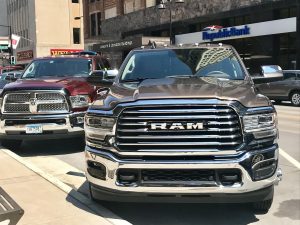
Ram’s 3500, right, and the extended-build of the outgoing Ram, left, boost combined Ram sales past Silverado and second to F-Series.
By John Gilbert
Regular readers of Newcarpicks.com have probably gathered over the years that I love cars of all kinds, and I also like trucks of a reasonably modest size. The difference between “love” and “like” is not insignificant. We also can reiterate that whether dealing with pickups or SUVs, my theory is that anything bigger than big enough is too big.
Cutting back on fossil fuels remains a key as we rumble down the street toward electrification of our vehicles. It never makes good sense to haul around a couple thousand extra pounds and several extra feet of length, and a ton of extra weight — unless you need it. We also bow to public preference, which has caused the top three vehicles in U.S. sales to be full-size pickup trucks, and the next two to be compact crossover SUVs, before we get to the best-selling cars.
The biggest surprise in over a decade is that the traditional 1-2 stature of the Ford F-Series and the Chevrolet Silverado has been disrupted, as the Ram has forcefully passed the Chevy with an extreme upsurge and is closer to challenging the Fords. Those sales figures include heavy-duty trucks above and beyond the full-size, so let’s examine two of the biggest, most potent, most capable, and perhaps the best monster.trucks available.
One is the Ram 3500, and not “just” the 3500. It’s the Ram 3500 Laramie Longhorn Crew Cab 4×4 Long Box, almost as long as the truck itself, which is about as huge as you can visualize a truck that is still legal to drive on city streets. Power is immense, from its 6.4-liter V8, which has 410 horsepower and 429 foot-pounds of torque, capable of towing 31,210 pounds of trailer, and that is if you don’t use the built-in fifth-wheel deal in the bed. The Ram, equipped with dual-rear wheels (dualies) comes in at $81,190.
The other big boy in this week’s evaluation is the No. 1 target of all pickup makers — the Ford Super-Duty F250, SRW 4×4 Crew Cab Limited Style-Side, without the dual wheels or the longest bed, but with a 6.7-liter Power Stroke turbo-diesel that runs with almost alarming silence — compared to the diesels we know and love — but carries a big stick. Or several of them. How about 32,000 pounds of sticks, or cement blocks, or anything else you can imagine? This potent turbo-diesel puts out 450 horsepower and an unheard of 935 foot-pounds of torque.
It is the smallest of the Ford Super-Duty family, which rises above the F150 and also includes the F350 and F450. But if you give it enough power, the F250 is plenty. This one is priced at $84,105, with the base price of $80,240 including just about all the luxury stuff Ford could think of.
Always the trouper, I drove both of these monsters around downtown Duluth, Minnesota, where the steep avenues were no match for either of these power plants. Because of the construction that dominates downtown Duluth, I had to circle around a couple of one-way streets, and then I remembered that my prized little Panasonic Lumix pocket camera, with the fantastic Leica lens, had stopped working. It’s about eight years old, and I would estimate that I’ve had about 10,000 photos published out of that little gem’s digital heart. I pulled into a diagonal parking slot right in front of Duluth Camera, making sure to swing wide enough for my dualies and the Kardashian-like rear wheel housings would clear, and fit tightly between the yellow stripe.
There were no parking meters in sight, so it looked like a free-parking area. I had parked adjacent to a year-old Ram 1500, so I shot a meaningful picture of the two of them together. I was in the store just long enough to find out they no longer do camera repairs, and walked back out to find a parking ticket wedged into may large driver’s door. Closer scrutiny of a small sign at the top of a pole said the block was set up for using a Smartphone to call in your license number and credit card to cover the required expense. A stealthy and quick parking control monitor had given both Rams parking tickets.
The significance of the old-style Ram is that while the 2019 Ram 1500 won everybody’s Truck of the Year competition for its redesign and sophistication, the company would continue to build and sell the old-style Ram as a bargain truck. Both are selling beyond the most optimistic hopes.
Automotive News, which compiles statistical evidence of everything automotive, shows there were 2,992,382 new cars sold in the first six months of 2019, which is a 9 percent drop from last year’s first half; compared to 6,841,952 light trucks, which includes pickups and SUVs, which represents a 2.1 percent rise — a total of more than twice the number of trucks to cars sold!
Ford’s F-Series retains its No. 1 status with 448,398 sales in the first six months of this year, but that is a tiny decrease of 0.6 percent from a year ago. The Silverado sold 255,463, a 12.1 percent drop, just when the new Ram — with came out about the same time as the renewed Silverado — sold 299,480 units, a whopping 28.2 percent increase.
By vaulting past the Silverado, the Ram moves into a strong, challenging second place to the F-Series. For the last month, F-Series sold 79,426, a slight increase of 0.3 percent over July of 2018, while the Ram sold 68,098 — representing a quite-astonishing 56.4 percent increase from the same month in 2018. The new Silverado sold 45,455, a decrease of 15 percent from the same month in 2018.
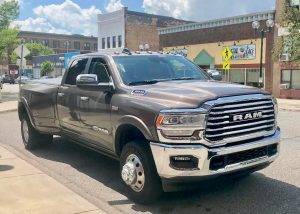
The lure of a home-made ice cream shop was incentive to .parallel park the Ram 3500,k long box, dualies, and all.
For those interested, the top 10 in U.S. vehicle sales are: 1. F-Series, 2. Ram, 3. Silverado, 4. Toyota RAV4, 5. Honda CR-V, 6. Honda Civic, 7. Toyota Camry, 8. Nissan Rogue, 9. Chevrolet Equinox, and 10. Toyota Corolla. The only three cars among the top 10 for the year are the Civic, the Camry and the Corolla. The Rogue, which stood fourth a year ago, ahead of prime rivals RAV4 and CR-V, has dropped 22.5 percent, but still holds fifth.
Truck-folks rule, and if you doubt it, I stopped to get some gas in the Ram, which took some serious maneuvering to avoid knocking over the gas pumps or the building itself, and as I opened the door and stepped with perfect timing to land on the instantly-appearing running board before descending the rest of the way to Earth, a pleasant female voice said, “Nice truck!” A woman refilling her Silverado pickup on the other side of the pumps, has a big truck, but she truly admired that I had a BIG truck.
For those hauling a heavy trailer, or a trailer house, it would seem logical to go up to the huge (huger?) turbo-diesel, a 6.7-liter inline six that climbs to 900 foot-pounds of torque, but there definitely is something to the sound of the 6.4 normally-aspirated V8 that sounds almost Viper-like with its throaty roar. And it takes off and hits 60 in about 6.2 seconds, if you believe Motor Trend. Stability and road-holding are exemplary in the big Ram, which, as they say, drives smaller than it is. The spacious room in the rear seat, with all the leather flaps and trim items that make it almost limousine-like, reinforces the image established by the front bucket seats.
The big Ram 3500’s surprising agility helped when I had to negotiate about 80 miles of single-lane orange-cone maneuvering for Interstate 35 resurfacing while driving to Minneapolis and back. And I showed 16.5 miles per gallon, which, as they say, is not bad for such a large truck.
It is a full crew cab with all of the luxury features that have made the Ram the darling of the pickup segment for 2019, with Laramie’s embossed leather interior, and that iPad-size 12-inch center screen that allows more connectivity functions than you and I could have imagined a couple of years ago. And it has the longest bed in the pickup world, fully sprayed with grippy stuff. The combination of the longest occupant compartment and the longest bed make something like its ParkSense front and rear parking assistance electronics seem somehow mandatory but inadequate. Parking is simple: Just find two parking places end to end and use ‘em both.
The Ram was painted Walnut Brown Metallic, with light mountain brown interior on its premium leather bucket seats.
The Ford Super-Duty is similar in utility and versatility, and helps keep Ford atop the segment for now, because along with the “normal” sized F150, the 250 joins the 350 and 450 among the heavyweights, and also has a new baby brother in the Ranger, which is a modest, medium-size pickup we will be reporting on in a few weeks.
The impressive thing about the 6.7 Turbo-diesel is that Ford is making its own diesel these days, and figured out a way to put the new clean-diesel fuel to good use and make the thing run strong and without the mind-numbing thrum of every other diesel in the truck biz. It has a 6-speed automatic, compared to the Ram 3500’s 8-speed, but the overflowing torque doesn’t seem to betray any shortcomings.
The Super-Duty Ford was painted Silver Spruce, which was a modest silvery-green that was very attractive, and harmonized with the Camelback leather interior. Like the Ram, it had running boards that slide out electrically from the body to meet your feet and at least go halfway toward reducing the pole-vault requirementt otherwise necessary to enter the vehicle.
I must confess that I didn’t get enough miles on the Super-Duty to require refueling, although when it was full it showed 700-some miles available before running out.
Both trucks had the gooseneck trailer towing device, surround-view rear camera, keyless entry, and all the connectivity and audio gadgets. If you’re real tall, you could sleep more comfortably in the extra-long Ram bed. If you want to go seriously off the road, you might prefer the Ford Super-Duty, which seems to have more skid-plate protection on the underside. If you like fancy interiors, you’ll have to choose for yourself. If you like powerful audio, both have premium units, with the Ram installing a 17-speaker Harmon Kardon upgrade and a power sunroof, while the F250 Super-Duty has a twin-
panel moonroof, and a 4G WiFi hotspot. Both of them had heated and cooling ventilated seats, and it had a massage feature on the front buckets.
My wife, Joan, found the Ford controls for the seat massagers. I never looked for them on the Ram. It probably had them too. Tough choice, but the Ram is on a sales rampage and could close the gap more as 2019 progresses. I haven’t yet become convinced that a gigantic truck that gets southward of 20 miles per gallon is the ideal vehicle, unless you really need it.
If you’re hauling a house trailer or a large RV, then get into the same mindset you had when choosing a house. Just be aware that your first house may not have had the amount of room of either the Ram 3500 or the Ford Super-Duty.
Upscale Prius Flashes Style, AWD, Great Economy
Filed under: Weekly test drives, Autos
By John Gilbert
When Toyota and Honda led the way into hybrid engineering, I was impressed to track their different techniques to combine electric motors with gasoline engines. Some resisted, and I realized I was risking my status as a card-carrying purist, but it was immediately apparent that hybrids were the stepping stone to what is surely a coming era of electric cars.
While Honda wavered a bit along the way, and other competitors from South Korea and Germany have emerged, the Toyota Prius has remained the vanguard. Toyota’s “Hybrid Synergy Drive” has powered the subcompact Prius to such popular status that some feel it has become the new icon for Toyota’s worldwide success, even replacing the Camry and Corolla as the company’s signature vehicle.
Consistency is Toyota’s hallmark, and it is the reason for the everlasting success of the midsize Camry and compact Corolla, but the Prius has countered that reputation, taking some chances with edgy styling and staying at the top of the technology game being played at the highest level of automotives.
Prius now has expanded to a diversified portfolio with different models and styles, and the standard front-wheel-drive models continue to show increasing fuel economy. Their consistency may have left some cynics behind, but amid competitive hybrid models from Honda, Hyundai and German competitors and assorted all-electric cars, there are reasons to take a new look at the Prius.
I have just had the opportunity to test a 2019 Prius Limited, the top of the line hatchback 4-door sedan with all-wheel drive. Interesting. The electric-motor-powered front-drive Priuses have perfected the ability to turn gas-engine power and regenerative braking into keeping the battery-pack electric motors going, but all-wheel drive seems a stretch.
Turns out, the 1.8-liter 4-cylinder engine is not tuned for highest power but to be efficiently coordinated with the electric motors, so its listed 121 horsepower doesn’t mean much. The test vehicle had performance-vehicle takeoff and swift highway operation.
The car was Supersonic Red, one of two new colors exclusive to Prius, and it practically glowed with brightness. It also has the wedge, fast-sloping arrow shape in silhouette, rising from a low nose and fitting well into the various contours that end up at the well-sculptured rear. The hatch has a huge window, which extends below the rear deck spoiler wing, which aids rear visibility greatly.
Front visibility for the driver is enhanced by the now-familiar positioning of the instruments and information screens on a centrally located region of the dashboard. That means without the speedometer binnacle, the driver looks straight down at the road ahead, with a head-up display.


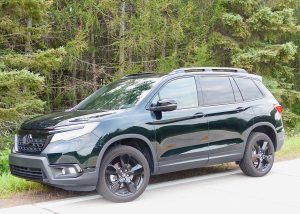
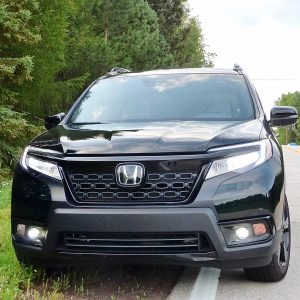
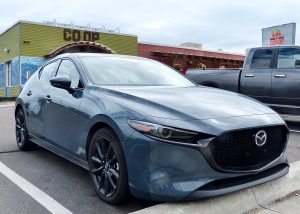
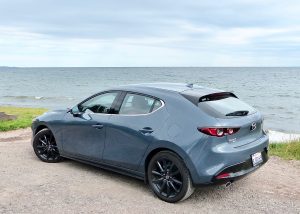
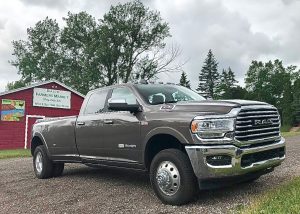
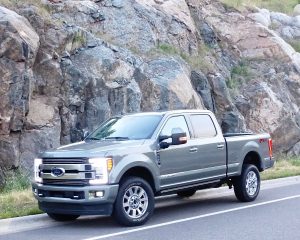

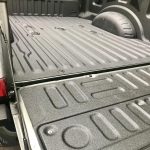
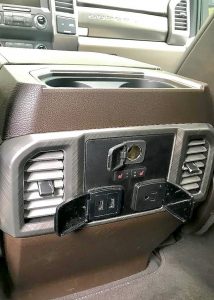
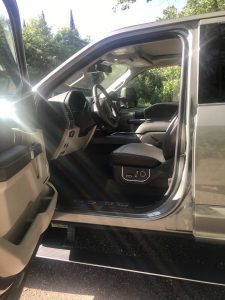
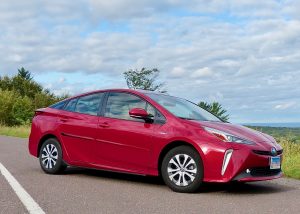
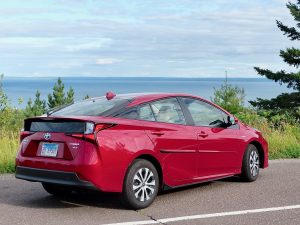
 John Gilbert is a lifetime Minnesotan and career journalist, specializing in cars and sports during and since spending 30 years at the Minneapolis Tribune, now the Star Tribune. More recently, he has continued translating the high-tech world of autos and sharing his passionate insights as a freelance writer/photographer/broadcaster. A member of the prestigious North American Car and Truck of the Year jury since 1993. John can be heard Monday-Friday from 9-11am on 610 KDAL(www.kdal610.com) on the "John Gilbert Show," and writes a column in the Duluth Reader.
John Gilbert is a lifetime Minnesotan and career journalist, specializing in cars and sports during and since spending 30 years at the Minneapolis Tribune, now the Star Tribune. More recently, he has continued translating the high-tech world of autos and sharing his passionate insights as a freelance writer/photographer/broadcaster. A member of the prestigious North American Car and Truck of the Year jury since 1993. John can be heard Monday-Friday from 9-11am on 610 KDAL(www.kdal610.com) on the "John Gilbert Show," and writes a column in the Duluth Reader.